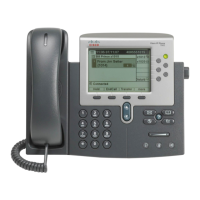1-9
Cisco Unified IP Phone 7962G and 7942G Administration Guide for Cisco Unified Communications Manager 7.0
OL-15483-01
Chapter 1 An Overview of the Cisco Unified IP Phone
Understanding Security Features for Cisco Unified IP Phones
Understanding Security Features for Cisco Unified IP Phones
Implementing security in the Cisco Unified Communications Manager system prevents identity theft of
the phone and Cisco
Unified Communications Manager server, prevents data tampering, and prevents
call signaling and media stream tampering.
To alleviate these threats, the Cisco IP telephony network establishes and maintains authenticated and
encrypted communication streams between a phone and the server, digitally signs files before they are
transferred to a phone, and encrypts media streams and call signaling between Cisco
Unified IP phones.
The Cisco Unified IP Phone 7962G and 7942G use the Phone security profile, which defines whether
the device is nonsecure, authenticated, or encrypted. For information on applying the security profile to
the phone, refer to the Cisco Unified Communications Manager Security Guide.
If you configure security-related settings in Cisco Unified Communications Manager Administration,
the phone configuration file will contain sensitive information. To ensure the privacy of a configuration
file, you must configure it for encryption. For detailed information, refer to the “Configuring Encrypted
Phone Configuration Files” chapter in Cisco Unified Communications Manager Security Guide.
Table 1-2 shows where you can find additional information about security in this and other documents.
Ta b l e 1-2 Cisco Unified IP Phone and Cisco Unified Communications Manager Security
To p i c s
Topic Reference
Detailed explanation of security, including set
up, configuration, and troubleshooting
information for Cisco Unified
Communications
Manager and Cisco Unified
IP Phones
Refer to Cisco Unified Communications Manager
Security Guide
Security features supported on the Cisco
Unified IP Phone
See the “Overview of Supported Security Features”
section on page 1-10
Restrictions regarding security features See the “Security Restrictions” section on page 1-17
Viewing a security profile name See the “Understanding Security Profiles” section on
page 1-12
Identifying phone calls for which security is
implemented
See the “Identifying Authenticated, Encrypted, and
Protected Phone Calls” section on page 1-13
TLS connection • See the “What Networking Protocols are Used?”
section on page 1-4
• See the “Adding Phones to the Cisco Unified
Communications Manager Database” section on
page 2-8
Security and the phone startup process See the “Understanding the Phone Startup Process”
section on page 2-7
Security and phone configuration files See the “Adding Phones to the Cisco Unified
Communications Manager Database” section on
page 2-8
Changing the TFTP Server 1 or TFTP Server 2
option on the phone when security is
implemented.
See Table 4-2, in the “Network Configuration Menu”
section on page 4-5

